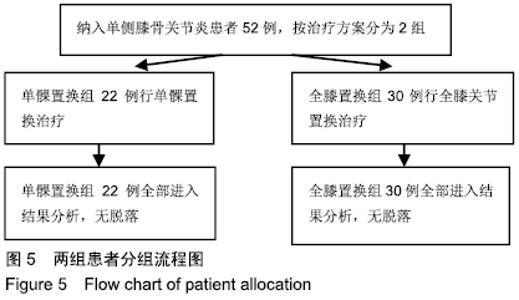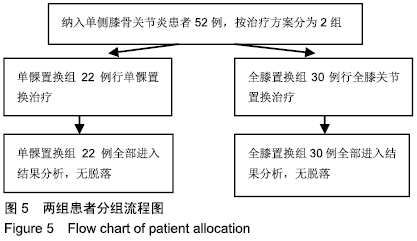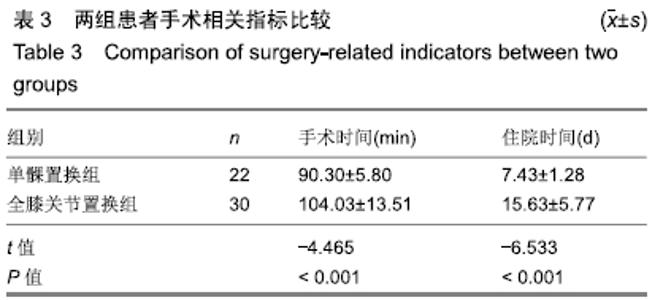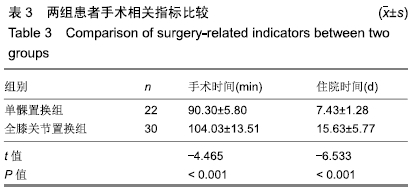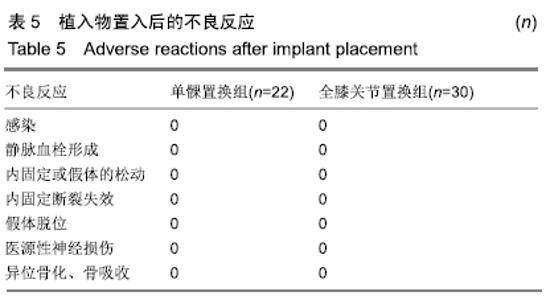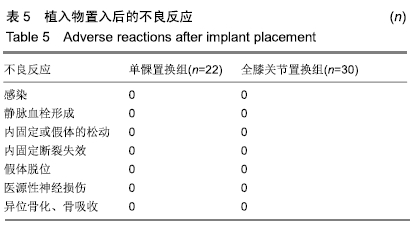[1] 许杰.骨关节炎的非药物及药物阶梯治疗[J].中华关节外科杂志(电子版),2018,12(1):131-140.
[2] 梁宁,SAMUEL YIH SHYAN WONG, NICK CLEMENT, 等. 单髁与全膝关节置换治疗内侧间室膝骨关节炎:5年假体在位率比较[J].中国组织工程研究,2015,19(53):8543-8548.
[3] GUNSTON FH. Polycentric knee arthroplasty: Prosthetic simulation of normal knee movement. J Bone Joint Surg (British Volume). 1971;53(2):272-277.
[4] NEWMAN J, PYDISETTY RV, ACKROYD C.Unicompartmental or total knee replacement:the 15 year results of a prospective randomised controlled trail. J Bone Joint Surg Br. 2009;91(1): 52-57.
[5] 安雪军,张宇明,魏杰,等.单髁置换术与全膝关节置换术治疗膝关节骨关节炎临床疗效的对比研究[J].中国药物与临床,2014,14(8): 1109-1110.
[6] 单鹏程,赵铁军,何名江,等.单髁置换术治疗膝内侧间室骨关节炎的中短期疗效及并发症分析[J].中华骨与关节外科杂志,2017,10(5): 377-381.
[7] 卞为伟,刘璠,唐晓波,等.单髁置换与全膝关节置换治疗单间室膝骨关节炎临床对比研究[J].中华关节外科杂志(电子版),2018,12(1): 30-34.
[8] 房小文,薛峰,盛晓文,等.单髁置换与全膝关节置换治疗内侧胫股关节炎早中期疗效比较[J].实用骨科杂志,2015,21(6):497-499.
[9] 朱超华,陈百成.单髁置换后翻修与初次行全膝关节置换患者远期临床效果对比:49例患者8-17年的随访[J].中国矫形外科杂志,2011, 19(1):86.
[10] LASKIN RS. Unicompartmental tibio femoral resurfacing arthroplasty. J Bone Joint Surg Am. 1978;60(2):182-185.
[11] CHRISTENSEN NO. Unicompartment alprosthesis forgon arthrosis:an ine year series of 575 knees from a Swedish hospital. Clin Orthop Relat Res. 1991;273:165-169.
[12] AHLBÄCK S, RYDBERG J. Röntgenologisk klassifikation och undersökningsteknik vid gonartros. Läkartidningen. 1980; 77(22): 2091-2096.
[13] WEIDOW J, CEDERLUND CG, RANSTAM J. Ahlbäck grading of osteoarthritis of the knee- Poor reproducibility and validity based on visual inspection of the joint. Acta Orthopaedica. 2006;77(2): 262-266.
[14] BERG KO, MAKI BE, WILLIAMS KI. Clinical and laboratory measures of postural balance in an elderly population. Arch Phys Med Rehab. 1992;73(11):1073-1080.
[15] THOMPSON M, MEDLEY A. Performance of community dwelling elderly on the timed up and go test. Phys Occup Ther Geriatr. 1995;13(3):17-30.
[16] LIN M, WANG HH, HU M, et al. Psychometric comparisons of the timed up and go,one- leg stand,functional reach,and tinetti balance measures in community-dwelling older people. J Am Geriatr Soc. 2004;52(8):1343-1348.
[17] 朱娟,钮金圆,张文通.计时起立行走和最大步行速度评估脑卒中患者功能的对比分析[J].中国康复医学杂志,2017,32(9):1026-1029+ 1034.
[18] 吴婉霞,徐武华,刘文权,等.早期本体感觉训练对全膝关节置换术后患者步行能力的影响[J].中国矫形外科杂志,2013,21(15): 1508-1512.
[19] 高霞,王茂斌.介绍FIM——一种残疾程度评测方法[J].中国康复医学杂志,1995,10(3):142-143.
[20] 瓮长水,王军,王刚,等.Berg平衡量表在脑卒中患者中的内在信度和同时效度[J].中国康复医学杂志,2007,22(8):688-690+717.
[21] 胡建平,伊文超,李瑞炎,等.本体感觉定量评估的可靠性初探[J].中华物理医学与康复杂志,2012,34(1):34-37.
[22] 王盛,杨菊,朱奕,等.平衡反馈训练仪用于脑损伤偏瘫患者静态平衡测试的信度与效度研究[J].中国康复医学杂志,2011,26(11): 1035-1038.
[23] DAWSON J, LINSELL L, ZONDERVAN K, et al. Epidemiology of hip and knee pain and its impact on overall health status in older adults. Rheumatology. 2004; 43(4): 497-504.
[24] BOURNE RB, CHESWORTH BM, DAVIS AM, et al. Patient satisfaction after total knee arthroplasty: who is satisfied and who is not. Clin Orthop Relat Res. 2010;468(1):57-63.
[25] 康凯,高石军,董江涛,等.膝关节单髁置换术的发展研究进展[J].中国矫形外科杂志,2014,22(2):130-133.
[26] MCKEEVER DC. The choice of prosthetic materials and evaluation of results. Clin Orthop. 1955;6: 17.
[27] 彭松,王波,符培亮,等.前交叉韧带缺陷对单髁置换疗效影响的研究[J].中国骨与关节杂志,2016,5(6):449-453.
[28] 卢明峰,李泽晖,朱东平,等.同一患者双膝单间室骨关节炎单髁置换与全膝关节置换的对比[J].中国组织工程研究,2018,22(3):343-349.
[29] 邬波,柳椰,杜明昌,等.膝关节单髁置换治疗膝内侧间室骨关节炎的疗效观察[J].中华骨与关节外科杂志,2017,10(2):123-125+131.
[30] 周义钦,吴海山.膝关节本体感觉与交叉韧带机械感受器的研究进展[J].骨科,2013,4(2):102-105+109.
[31] 马燕红,程安龙,江澜,等.前交叉韧带损伤后膝关节本体感觉的改变[J].中华物理医学与康复杂志,2004,26(4):52-53.
[32] 张太良,张磊,廉志明,等.关节镜下前交叉韧带重建保留残端与否干预膝关节本体感觉功能恢复的Meta分析[J].中国组织工程研究, 2017,21(3):471-477.
[33] TAKACS J,CARPENTER MG,GARLAND SJ,et al.The role of neuro-muscular changes in aging and knee osteoarthritison dynamic postural control. Aging Disease. 2013;4(2):84-99.
[34] KARAKAYA MG, RUTBİL H, AKPINAR E, et al. Effect of ankle proprioceptive training on static body balance. J Phys Ther Sci. 2015;27(10):3299-3302.
[35] ROSSIGNOL S,DUBUC R,GOSSARD JP. Dynamic sensorimotor interactions in locomotion. Physiol Rev. 2006;86(1):89-154.
[36] 张竞,张金庆,金贺楠,等.全膝关节置换术与膝关节单髁术置换患者住院费用构成比较[J].临床军医杂志,2017,45(8):870-871.
[37] RODRIGUEZ-MERCHAN EC, GOMEZ-CARDERO P. Unicompartmental knee arthroplasty: Current indications, technical issues and results. EFORT Open Rev. 2018;3(6): 363-373.
|
